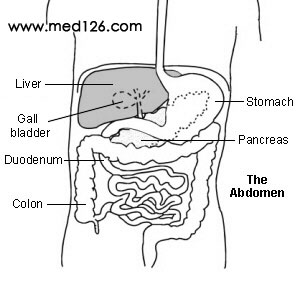Understanding the gallbladder and bile
Bile is made in the liver. It is passed into tiny tubes called bile ducts. These join together (like the branches of a tree) to form the main bile duct. Bile constantly drips down the bile ducts, into the main bile duct, and into the gut.
The gallbladder lies under the liver on the right side of the upper abdomen. It is like a pouch which comes off the main bile duct and fills with bile. It is a 'reservoir' which stores bile. The gallbladder contracts (squeezes) when we eat. This empties the stored bile back into the main bile duct. The bile passes along the remainder of the bile duct into the duodenum (the first part of the gut after the stomach).
Bile helps to digest food, particularly fatty foods.
What are gallstones?
Gallstones occur when bile, which is normally fluid, forms stones. They commonly contain lumps of cholesterol-like (fatty) material that has solidified and hardened. Sometimes bile pigments or calcium deposits form gallstones. Sometimes just a few small stones are formed, sometimes a great many. Occasionally, just one large stone is formed.
About 1 in 3 women, and 1 in 6 men, form gallstones at some stage in their life. They become more common with increasing age. The risk of forming gallstones increases with pregnancy, obesity, and if you take certain medicines. Being vegetarian and drinking a moderate amount of alcohol reduces the risk of forming gallstones.

What problems can gallstones cause?
Usually none
Most people with gallstones do not know they have them. The stones stay in the gallbladder and cause no symptoms. (Because gallstones are common, they are often found when the abdomen is scanned or x-rayed. These tests may be done when looking for the cause of abdominal symptoms. If gallstones are found this does not always mean that they are the cause of symptoms. They may be, but they are sometimes blamed for causing symptoms which are due to other causes.)
Possible problems
About 3 in 10 people with gallstones develop symptoms or problems. These include:
- Biliary colic. This is a severe pain in the upper abdomen. The pain is usually worst to the right-hand side, just below the ribs. It is caused by a stone that gets stuck in the cystic duct. This is the small tube that takes bile from the gallbladder to the bile duct. The gallbladder then squeezes hard to dislodge the stone, and this causes pain. The pain eases and goes if the gallstone is pushed out into the bile duct (which then usually passes out into the gut), or if it falls back into the gallbladder. Pain can last just a few minutes, but more commonly lasts several hours. A severe pain may only happen once in your lifetime, or it may flare up from time to time. Sometimes less severe but niggly pains occur now and then, particularly after a fatty meal when the gallbladder contracts most.
- Inflammation of the gallbladder. This is called cholecystitis. This can lead to infection in the gallbladder. Symptoms usually develop quickly and include abdominal pain, fever, and being generally unwell. You will normally be admitted to hospital and have your gallbladder removed soon if you develop this problem.
- Jaundice This is an uncommon complication of gallstones. It occurs if a gallstone comes out of the gallbladder, but gets stuck in the bile duct. Bile then cannot pass into the gut, and so seeps into the bloodstream. This causes you to go yellow (jaundiced). The stone may eventually be passed into the gut. However, it is common to need an operation to remove a gallstone which has become stuck in the bile duct. (Note: there are many other causes of jaundice apart from gallstones.)
- Pancreatitis. This is an inflammation of the pancreas. The pancreas makes a fluid rich in enzymes (chemicals which digest food). The pancreatic fluid travels down the pancreatic duct. The pancreatic duct and bile duct join together just before opening into the duodenum. If a gallstone becomes stuck here it can cause pancreatitis which is a painful and serious condition.
- Other complications occasionally occur such as severe infection of the bile duct (cholangitis), and other uncommon gut problems.
[1] [2] [3] 下一頁

